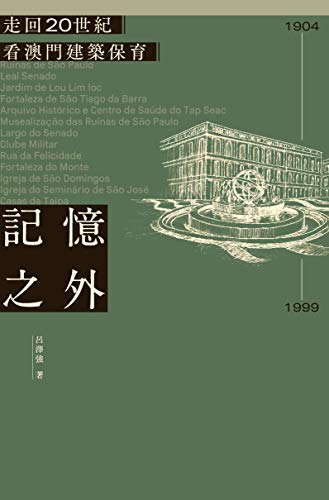1
/
of
1
Beyond Memory: Going Back to the 20th Century to See Macao’s Architectural Conservation
Beyond Memory: Going Back to the 20th Century to See Macao’s Architectural Conservation
Regular price
MOP$111.00
Regular price
Sale price
MOP$111.00
Unit price
/
per
Couldn't load pickup availability
Macau is one of the cities in Asia that initiated heritage protection earlier. In 1926, the Portuguese government of Macao promulgated regulations to protect the ruins of the Church of the Mother of God, later known as the Ruins of St. Paul's; in 1953, the protection of architectural heritage began; and in 1976, Macau's first cultural heritage protection legislation was promulgated.
Therefore, although Macao has experienced large-scale urban development since the 1980s, some valuable historical buildings and neighborhoods can still be preserved relatively completely, making Macao unique from other neighboring cities.
However, the purpose of the Macao Portuguese government to carry out architectural heritage protection in Macao is complicated. The return of Macau in 1999 marked the end of the Portuguese colonial empire. Therefore, the protection of heritage by the Macao-Portuguese government is not simply for the development of tourism or for the preservation of historical culture, but involves cultural colonial policies.
This book is divided into 13 chapters. By describing 16 architectural protections, it introduces the history of Macao’s architectural protection in the past 100 years by the Macao and Portuguese governments in a simple and easy way We can also think about how the Portuguese government protects the architectural heritage in an attempt to allow Portuguese culture to continue to subtly influence the city after the transfer of power.
Therefore, although Macao has experienced large-scale urban development since the 1980s, some valuable historical buildings and neighborhoods can still be preserved relatively completely, making Macao unique from other neighboring cities.
However, the purpose of the Macao Portuguese government to carry out architectural heritage protection in Macao is complicated. The return of Macau in 1999 marked the end of the Portuguese colonial empire. Therefore, the protection of heritage by the Macao-Portuguese government is not simply for the development of tourism or for the preservation of historical culture, but involves cultural colonial policies.
This book is divided into 13 chapters. By describing 16 architectural protections, it introduces the history of Macao’s architectural protection in the past 100 years by the Macao and Portuguese governments in a simple and easy way We can also think about how the Portuguese government protects the architectural heritage in an attempt to allow Portuguese culture to continue to subtly influence the city after the transfer of power.
ISBN:9789620447365
出版:三聯
作者:呂澤強
分類:Book Selection Exhibition─Walking around the city, using books to guide the way,Text


